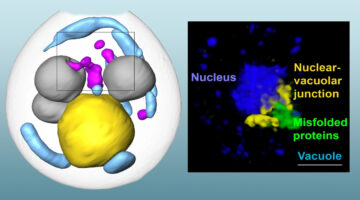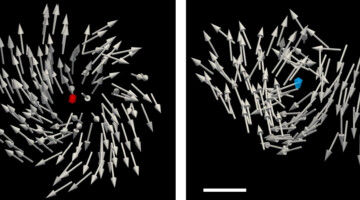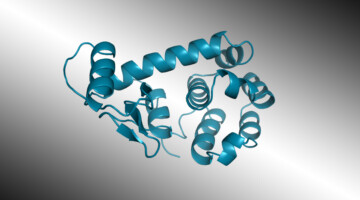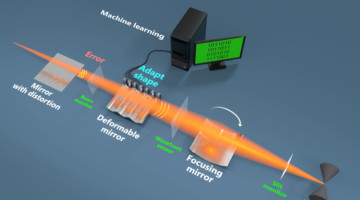Researchers integrated several approaches, such as cryogenic 3D imaging at the ALS, to define a novel cellular pathway—involving a shared “garbage dump”—for clearing misfolded proteins from cells. The pathway is a potential therapy target for age-related diseases like Alzheimer’s, Huntington’s, and Parkinson’s diseases. Read more »![]()
![]()
Coaxing Molecules to Stand Tall for Better Solar Cells
Multimodal probes revealed a way to prevent the formation of undesirable phases in a perovskite-type compound that shows promise for the efficient harvesting of light for solar cells. The work led to new fabrication protocols that resulted in devices with improved power-conversion efficiencies and operational stability. Read more »![]()
![]()
Surface Engineering Boosts Water-Splitting Efficiency
Researchers modified the surface of an electrocatalyst to maximize its efficiency at splitting water. The optimized material is approximately 40 times more efficient than similar commercial electrocatalysts and could help make the production of clean hydrogen fuel more sustainable and economical. Read more »![]()
![]()
Chiral Twists and Turns Lead Way to New Materials
Researchers found that, in crystals with structural chirality (left- or right-handedness), tuning the electronic behavior reveals hidden chiral phases and singularities. The results provide a new way to predict, test, and manipulate novel materials that exhibit desirable properties for next-generation electronic and spintronic devices. Read more »![]()
![]()
Plant Enzyme Builds Polymers That Fortify Cell Walls
With data obtained at the ALS, researchers gained insight into how an enzyme orchestrates the synthesis of a pectin polymer that imparts strength and flexibility to plant cell walls. The work could lead to improved biofuel production and guide the design of polymers with tailored functionalities for industrial or biomedical applications. Read more »![]()
![]()
Spiraling Beams Differentiate Antiferromagnetic States
Using spiraling x-ray beams, researchers differentiated between energetically equivalent (“degenerate”) states in an antiferromagnetic lattice. The work shows the potential of these beams to probe properties that would otherwise be inaccessible, to better understand phenomena of fundamental interest and for applications such as spintronics. Read more »![]()
![]()
Probing Walls between Electrically Polarized Domains
Researchers used infrared light to investigate the properties of the domain walls that separate electrically polarized (ferroelectric) regions in a rare-earth ferrite material. An understanding of domain-wall behavior is relevant to the development of advanced logic and memory applications for ultralow-power digital devices. Read more »![]()
![]()
Imaging Topological Magnetic Monopoles in 3D
Researchers created topologically stable magnetic monopoles and imaged them in 3D with unprecedented spatial resolution using a technique developed at the ALS. The work enables the study of magnetic monopole behavior for both fundamental interest and potential use in information storage and transport applications. Read more »![]()
![]()
Chatbot-Style AI Designs Novel Functional Protein
Researchers used an artificial intelligence (AI) algorithm, similar to those used in natural-language (“chatbot”) models, to design a functional protein that was then structurally validated at the ALS. The work could speed the development of novel proteins for almost anything from therapeutics to degrading plastic. Read more »![]()
![]()
Shaping X-Ray Mirrors Using Machine Learning
Researchers used machine learning to predict and control the shape of an x-ray mirror’s surface with exquisite accuracy and precision. The work represents a key step toward mirrors that can fully exploit the x-rays from upgraded, state-of-the-art light sources and could also enable the engineering of x-ray beams with novel characteristics. Read more »![]()
![]()
- « Previous Page
- 1
- 2
- 3
- 4
- 5
- 6
- …
- 13
- Next Page »









